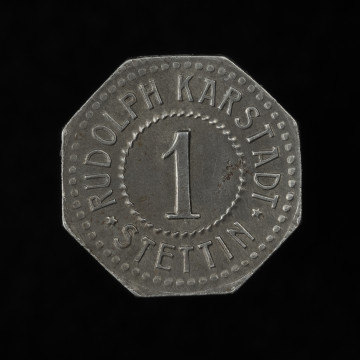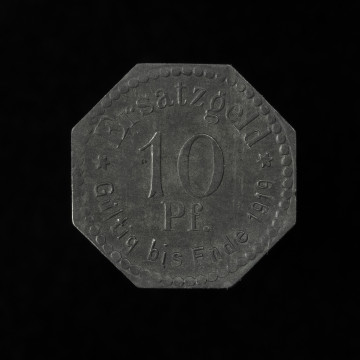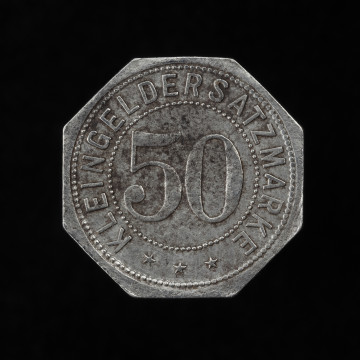
1 pfennig
1901 — 1925
National Museum in Szczecin
Part of the collection: Scrip
Almost immediately after money made of precious metals was introduced, the idea of its substitute, replacement money, minted in ordinary, generally available metals, often used as a means of payment prior to the use of silver and gold, was born. However, the replacement of precious bullion with low-cost metals was not the rule. An interesting situation occurred in Greece, during the siege of Athens by the Spartans in 406 BC, when, in the absence of silver coins, their substitutes were minted in gold, which at the time was not considered at all to be a material for the production of money. Replacement money also functioned in private estates, industrial plants and companies settling accounts with their employees partially bypassing the official currency. They could pay with it in the company’s canteens. This arrangement was very convenient for the employer, as he did not have to secure official funds in full for making payments. At the same time, the workers purchased goods, usually food, which the employer produced himself or else bought them cheap at wholesale prices. If they were sold with a small margin, the workers would also benefit. Private replacement money was also widely used in Germany during the First World War amid problems with accessibility to small coins. Retail companies handed out 'change' in them, and customers could pay with them during their next shopping trip to the venue. This was also the practice of the Rudolph Karstadt department store in Szczecin. He had commissioned the company L. Chr. Lauer in Nuremberg for a series of zinc-minted octagonal replacement coins worth 1, 5, 10 and 50 pfennig, while a one-pfennig coins were also punched in iron. They bore the name and location of the shop and the denomination with the information that the customer was handling a small replacement medium of exchange (German Kleingeldersatzmarke). In addition to their purely practical function, the replacement coins issued by trading companies also tied the customer to the particular shop and played a certain, most likely unintentional, advertising role. Mieszko Pawłowski
Other names
5 Pfennig, Notgeld
Author / creator
Object type
token coin
Technique
coining
Material
zinc
Origin / acquisition method
acquisition
Creation time / dating
Creation / finding place
Owner
Muzeum Narodowe w Szczecinie (1945- )
Identification number
Location / status

1901 — 1925
National Museum in Szczecin

1917
National Museum in Szczecin

1901 — 1925
National Museum in Szczecin
DISCOVER this TOPIC
Museum of King Jan III's Palace at Wilanów
DISCOVER this PATH
Educational path